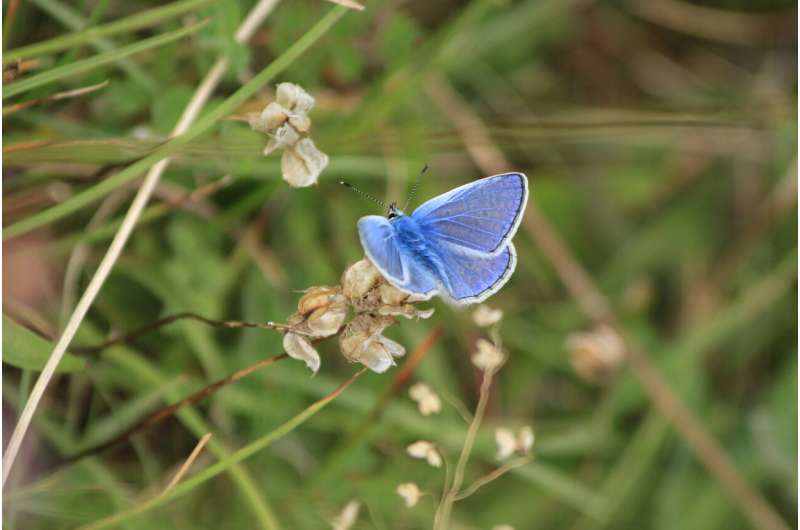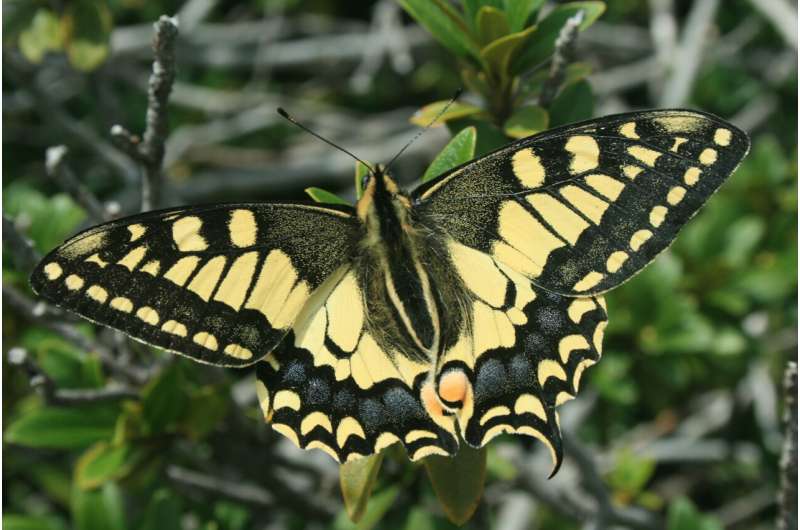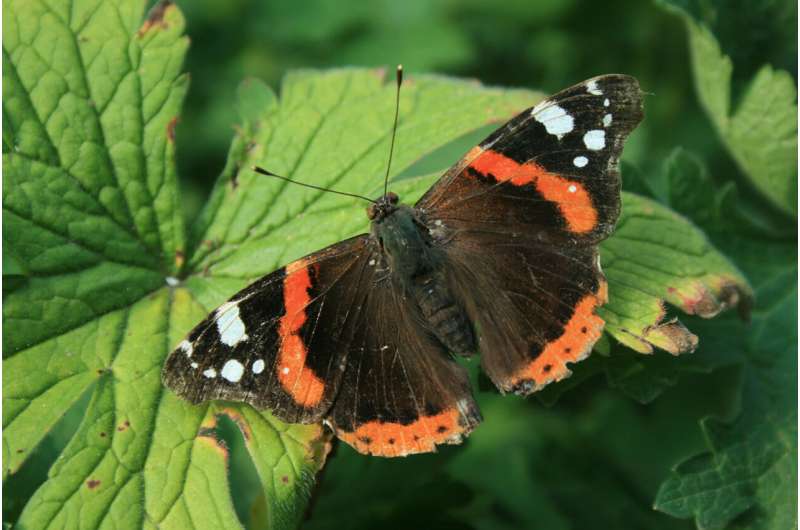This article has been reviewed according to Science X's editorial process and policies. Editors have highlighted the following attributes while ensuring the content's credibility:
fact-checked
peer-reviewed publication
trusted source
proofread
Study finds Spanish butterflies are better at regulating their body temperature than their British cousins

Butterfly populations in Catalonia in northern Spain are better than their UK counterparts at regulating their body temperature by basking in the sunshine, but rising global temperatures due to climate change may put Spanish butterflies at greater risk of extinction.
An international study, led by the University of Cambridge and the Institut de Biologia Evolutiva (IBE) in Barcelona, has found that butterflies use different methods to regulate their body temperature. In Catalonia, butterflies tend to angle their wings towards the sun to warm up at lower temperatures, while British butterflies rely more on finding warm microclimates.
However, as temperatures rise, both populations switch to heat-avoiding behavior. As global temperatures rise, British butterflies may initially benefit, while Spanish butterflies may not be able to survive if they are not able to adapt quickly enough.
The study results are reported in the Journal of Animal Ecology.
Habitat loss, particularly in the UK, is an equally important threat to butterflies. Diverse habitats offer butterflies a greater variety of microclimates, and initiatives such as "no-mow May," allowing wildflowers to grow along roadsides, and planting more trees can help counter habitat loss.
Like all insects, butterflies are cold-blooded, and use their environment to regulate their internal temperature. Understanding how butterflies thermoregulate is important for predicting which species are most at risk from the effects of climate change.
In a study published in 2020, several of the same researchers showed that there are significant variations in the ability of different UK butterfly species to maintain a suitable body temperature. Species that rely mostly on shade to keep cool are at greatest risk of population decline, due to climate change and habitat loss.

"The first study in the UK showed that butterflies are pretty good at regulating their body temperature in this cooler climate, but we wanted to see whether butterflies in a warmer climate, such as Spain, are doing anything differently," said lead author Eric Toro-Delgado from IBE, a joint center of the Consejo Superior de Investigaciones Científicas (CSIC) and Universitat Pompeu Fabra (UPF), "And if there are differences, what mechanisms might be driving it?"
"In Spain, butterflies spend much more time at their optimum temperature since it's warmer, but there's also a greater risk of overheating," said Dr. Andrew Bladon from Cambridge's Department of Zoology, the study's senior author. "We wanted to see whether the results we got from our UK data would be repeatable in a different environment."
For the current study, the researchers collected data similar to that of the 2020 UK paper, but from butterflies in Catalonia. They measured body temperature, air temperature, and perch temperature for almost 800 adult butterflies from 23 different species. For ten of these species, the researchers had comparable data from the UK.
"We hypothesized that Spanish butterflies might show adaptations to their warmer climate, which could give us an indication of how British butterflies might need to adapt to cope with climate change," said Bladon.
The researchers found that on a community level, butterflies in Catalonia were better at regulating (buffering) their body temperature than British butterflies. Butterflies in both countries switch from heat-seeking to heat-avoiding behavior once air temperatures reach approximately 22°C. However, the communities differ in the use of buffering mechanisms, with British populations depending more on microclimates for thermoregulation than Catalan populations.
Many landscapes in the UK do not provide a sufficient diversity of thermal environments, with alternating areas of shade and sun. For UK butterflies that rely on microclimates to regulate body temperature, habitat and biodiversity loss is a major threat. In Catalonia, one of the reasons why butterflies are better at regulating their temperature could be because butterflies have many more thermal options available to them.

"In the UK, many of our nature reserves are like islands, with little variety in between," said Bladon. "If we can provide them with field margins, biodiverse road verges, more wildflowers, and longer grass, butterflies can more easily move through the landscape, helping them find their preferred temperatures so they can thrive."
Although Catalan butterfly populations seem to be able to thermoregulate successfully at present, rising global temperatures due to climate change put them at greater risk, since it is so warm in Spain already.
"In the UK study, the Cambridge team found that wing size was related to the ability of a species to regulate its body temperature, and that species with large wings were better at it," said Toro-Delgado. "We expected to find a similar result in Spain, but we didn't. This is likely because in a warm country like Spain, the ability to avoid heat is preferable, and wings may play a less relevant role in this than in warming up."
"Because of rising global temperatures, the UK's climate is becoming a little bit more like Spain, so climate change may benefit British butterflies in the short term," said Bladon. "But what's striking is butterflies in both countries showed signs of heat avoidance. And the Catalan butterflies are at greater risk since they are already near their thermal optimum."
The researchers say that beyond rising temperatures, butterflies are also at risk from associated climate impacts, such as droughts or heat waves. These extreme weather events can not only push butterflies past their thermal limits, but also can kill the plants on which their caterpillars rely.
"Climate change is a two-pronged attack that can take out both adult butterflies and their caterpillars," said Toro-Delgado. "Climate change and biodiversity loss go hand in hand, and we urgently need to address both if we're going to protect important species like butterflies."
More information: Regional differences in thermoregulation between two European butterfly communities, Journal of Animal Ecology (2024). DOI: 10.1111/1365-2656.14039
Journal information: Journal of Animal Ecology
Provided by University of Cambridge




















